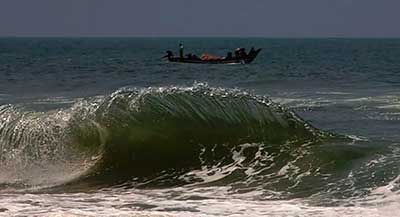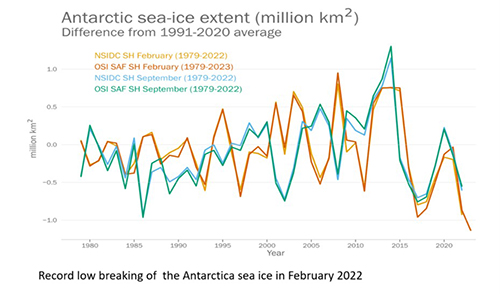Date: 24/04/2023
Relevance: GS-3: Biodiversity and Environment.
Key Phrases: World Meteorological Organization, State of the Global Climate,Greenhouse Gas Bulletin,Global Atmosphere Watch Report, satellite altimeter record, Indian Ocean Dipole, Austral Winter.
Context:
- The World Meteorological Organization (WMO) recently released its “State of Global Climate 2022” report, which warns of a continued rise in sea levels globally.
About World Meteorological Organization
- The World Meteorological Organization (WMO) is a specialized agency of the United Nations (UN) responsible for coordinating international efforts to monitor and understand the Earth's climate and weather patterns.
- Established in 1950, the WMO has 193 member states and territories, making it one of the largest and most widely respected international organizations focused on climate and weather.
- Its headquarters is in Geneva, Switzerland.
- The organization's mission is to facilitate the exchange of meteorological information and services between member countries, and to promote cooperation on issues related to weather, climate, and water resources.
- Reports published by WMO:
- State of the Global Climate
- Greenhouse Gas Bulletin
- Global Atmosphere Watch Report
- Guidelines for Climate Services
- World Climate Services Programme Report
Global Mean Sea Level Rise:
- Global mean sea level continued to rise in 2022, reaching a new record high for the satellite altimeter record (1993–2022).
- The rate of global mean sea level rise has doubled to 4.62 mm per year during 2013–2022 from 2.27 mm per year in 1993–2002.
- Waters would continue to rise for “thousands of years” because of high levels of greenhouse gases.
Indian Ocean Dipole and Monsoon:
- On Indian Ocean Dipole (IOD), which has a direct relation with good or bad monsoon, the UN weather body said that the positive phase of the IOD is characterised by below-average sea surface temperature (SST) in the eastern Indian Ocean and above average SSTs in the west.
- The negative phase has the opposite pattern.
- “The resulting change in the gradient of SST across the ocean basin affects the weather of the surrounding continents, primarily in the southern hemisphere.
- Positive IOD events are often, but not always, associated with El Niño and negative events with La Niña.
Negative IOD:
- For the second consecutive year, a negative IOD developed during austral winter.
- In combination with La Niña, this phase contributed to wet conditions across much of Australia in late austral winter and spring in 2022.
- It was the wettest spring and wettest October on record for New South Wales and Victoria, and the second-wettest spring nationally after 2010.
- Major flooding affected multiple regions in the spring, particularly across large areas of eastern Australia.
- The negative IOD returned to neutral as austral summer began.
- The negative IOD, in combination with La Niña, contributed to the ongoing dry conditions in eastern Africa.
Note:
- The Austral Winter is the winter season in the southern hemisphere, which generally lasts from June to August. It is called "Austral" because it is the winter season in the southern part of the world, including countries such as Australia, New Zealand, South Africa, and most of South America.
Extreme Weather Events in India and Pakistan:
- The WMO report mentioned grain (wheat) yields in India were reduced by the extreme heat in 2022 and there were a number of forest fires, particularly in Uttarakhand.
- It further said the pre-monsoon period was exceptionally hot in both India and Pakistan.
- There was also significant flooding in India at various stages during the monsoon season last year, particularly in the North-east during June, with over 700 deaths reported during the season from flooding and landslides, and a further 900 deaths from lightning.
Indian Monsoon Onset and Withdrawal:
- The UN agency said the Indian Monsoon onset was earlier than normal and the withdrawal later than normal in 2022.
- The majority of the Indian subcontinent was wetter than average and the monsoon extended farther westward than usual towards Pakistan.
What steps can be taken to mitigate this problem?
- Reduce greenhouse gas emissions:
- Implement carbon pricing mechanisms and support the development of clean energy sources
- Encourage industries to adopt sustainable practices and technologies
- Promote public awareness campaigns to educate individuals on reducing their carbon footprint
- Increase resilience to extreme weather events:
- Develop early warning systems and disaster response plans for vulnerable regions
- Invest in infrastructure to withstand extreme weather conditions, such as flood barriers and resilient buildings
- Support communities in adapting to climate change through education, training, and financial assistance
- Foster international cooperation:
- Encourage global cooperation and collaboration to address the challenges of climate change
- Promote the exchange of knowledge and best practices among countries and regions
- Support the development of climate policies and regulations at the international level
- Enhance research and innovation:
- Invest in research and development to improve our understanding of the changing climate and its impacts
- Develop new technologies to reduce emissions and mitigate the effects of climate change
- Promote innovation in areas such as energy storage and carbon capture and storage
- Promote sustainable land use:
- Support sustainable agriculture and forestry practices to reduce emissions and enhance carbon sequestration
- Encourage the preservation of natural habitats and ecosystems to maintain biodiversity and ecological resilience
- Promote sustainable urban planning to reduce the carbon footprint of cities and improve livability.
Conclusion:
- It is essential for policymakers and individuals to take decisive steps to reduce carbon footprint and promote sustainable practices to protect the planet's future.
- The WMO's report serves as a stark reminder of the growing threat of climate change and the need for urgent action to safeguard our planet and its inhabitants.
Source: The Hindu BL
Mains Question:
Q. What is the Indian Ocean Dipole (IOD), and how does it affect the weather patterns in the southern hemisphere? Discuss the positive and negative phases of the IOD, and their impact on monsoons. (250 Words).
























